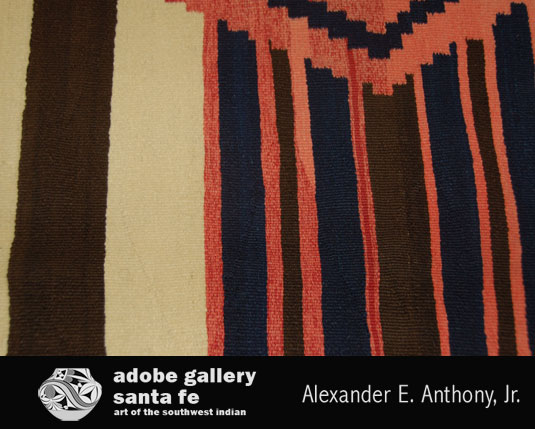Masterpiece Navajo Third Phase Chief Blanket, circa 1865-1870 [SOLD]
+ Add to my watchlist Forward to Friend
- Category: Navajo Textiles
- Origin: Diné of the Navajo Nation
- Medium: wool, cochineal and indigo dyes
- Size: 53 x 62 inches
- Item # C3931 SOLD
The earliest Navajo textiles discovered were those found in Massacre Cave in 1805. Those were banded designs as found on Navajo and Pueblo blankets from the eighteenth century. But, by the early 1800s, Navajo weavers began to experiment with design patterns. The Navajo were excellent basket weavers, so learning to weave with wool was just an advancement in the process.
When Mexico won its independence from Spain in 1821, a trade route from Mexico City to Nuevo Mexico was established and trade goods were on their way north. Additionally, the Santa Fe Trail from St. Louis to Santa Fe provided new materials previously unknown. Red bayeta trade cloth, and commercial dyes and yarns became abundant. Previously, there was no good red dye available from plant materials. The best source of red dye was from the small cactus beetles which the weavers ground up and formed a powder from which to make a red dye. It took thousands of those beetles to dye enough yarn for a single textile.
The early 1800s ushered in the Classic Period of Navajo Weaving. The most widely collected textile of the Classic Period is the Chief Blanket, so named because the wealthy Plains Indians could trade the Navajo for these prestigious textiles. Among the Plains Indians, they were a prized possession.
The first “Chief Blanket” was a design of alternating brown and white horizontal stripes. They were, however, more finely woven than the 18th-century stripe textiles. Those First Phase Chief Blankets were woven between 1800-1850. By the end of that phase, weavers were more confident and experimental and began incorporating red into the pattern, resulting in what is now known as the Second Phase Chief Blanket (1850-1865). By the 1860s, the weavers were emboldened and exploded with confidence and added nine large diamond spots over the First and Second Phase design, resulting in the Third Phase Chief Blanket. The blanket phase of Navajo textiles came to an end in the 1880s when traders encouraged the weavers to make larger weavings useful as rugs. That was what they had a market for.
In this Third Phase Chief Blanket, the weaver superimposed the large nine diamonds over the central bands of the textile, which was a Second Phase design, and over the wide brown and white stripes, which was a First Phase design. She achieved a layered effect, resulting in a three-dimensional appearance.
The red in this textile is cochineal dyed yarn, a red dye made from the cactus beetle. The white and brown stripes are natural undyed native wool, surely from the weaver’s own herd of sheep. The blue stripes were achieved with indigo dye. The Third Phase blanket, when incorporating cochineal dyed yarn, is the most spectacular because of the varying shades of red from different dye lots. When bayeta trade cloth or aniline dyed yarns are seen in a Third Phase blanket, the red color is the same throughout, depriving the textile of visual changes in viewing the piece. This textile is truly a masterpiece.
Condition: excellent condition
Provenance: from a gentleman’s collection in Santa Fe, New Mexico
Reference and Recommended Reading; The Navajo Weaving Tradition – 1650 to the Present by Alice Kaufman and Christopher Selser, E. P. Dutton, Inc., New York. 1985.

- Category: Navajo Textiles
- Origin: Diné of the Navajo Nation
- Medium: wool, cochineal and indigo dyes
- Size: 53 x 62 inches
- Item # C3931 SOLD



